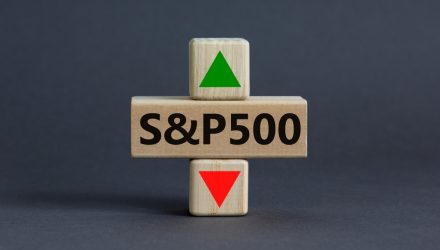The S&P 500 posted its highest close of the year on Friday as it capped off a fifth consecutive week of gains. The index finished the week up 0.8% from last Friday and is currently up 20.15% year to date. The S&P 500 is now just 4.21% below its record close from January 3, 2022.
Here is a snapshot of the index over the past 5 days:
Here is a snapshot of the index from the past six months with a 50-day moving average:
The U.S. Treasury put the closing yield on the 10-year note, as of December 1st, at 4.22% which is above its record low (0.52% on 8/4/2020). The 2-year note is at 4.56%. ETFs associated with Treasuries include: iShares 1-3 Year Treasury Bond ETF (SHY), iShares 7-10 Year Treasury Bond ETF (IEF), and iShares 20+ Year Treasury Bond ETF (TLT). See our latest Treasury Snapshot here.
S&P 500: A Perspective on Drawdowns
On October 9, 2007 the S&P 500 reached a then all-time high, closing the day at 1565.15. Then on March 9, 2009, the index dropped ~57% off of its high from exactly 17 months before, closing the day at 676.53. This time period became known as the Global Financial Crisis. It took over 5 years before the index reached a new then all-time high on March 28, 2013, where it closed out at 1569.19. The chart below is a snapshot of record highs and selloffs since the 2007 peak reached on October 9, 2007.
What happens if we take out the Global Financial Crisis? Here’s a snapshot the same chart above where the start date has been changed to the trough reached on March 9, 2009. Note the recent selloffs in 2022.
Here’s a table with the number of days of a 1% or greater change in either direction and the number of days of corrections (down 10% or more from the record high) going back to 2013.


Here is a linear chart of the index since October 9, 2007:
Here is a linearly scaled version of the same chart with the 50- and 200-day moving averages. As of November 3rd, the index has been above both its 50-day and 200-day moving averages.
S&P 500: A Perspective on Volatility
For a sense of the correlation between the closing price and intraday volatility, the chart below overlays the S&P 500 since 2007 with the intraday price range. I’ve also included a 20-day moving average to identify trends in volatility.
S&P 500 versus S&P Equal Weight
The S&P 500 is market cap-weighted index which includes roughly the 500 largest U.S. stocks spanning 11 sectors. The S&P 500 Equal Weight Index includes the same constituents as the S&P 500 but each company is equally weighted at a fixed weight. So how do these two indexes match up against each other this year?
As of December 1st, the S&P 500 is currently up 20.15% while the S&P Equal Weight is up 6.32%.
ETFs associated with the S&P 500 include: iShares Core S&P 500 ETF (IVV), SPDR S&P 500 ETF Trust (SPY), Vanguard S&P 500 ETF (VOO), SPDR Portfolio S&P 500 ETF (SPLG), and Invesco S&P 500® Equal Weight ETF (RSP).
For more news, information, and analysis, visit the Innovative ETFs Channel.
















